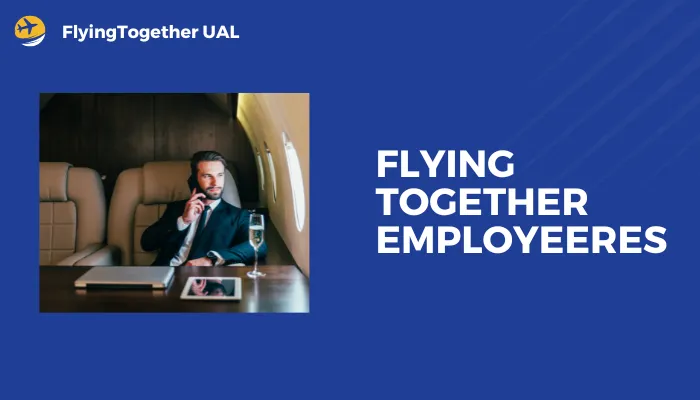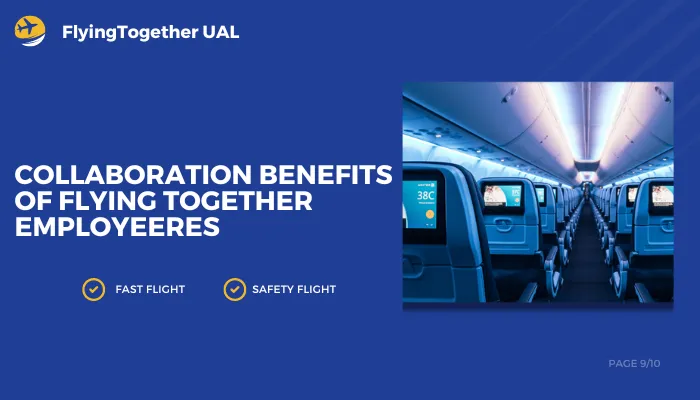
Meet “Flying Together EmployeeRES”, a powerful platform built to empower employees and improve collaboration within the airline industry.

Flying Together EmployeeRES
Where information silos exist, communication channels are fragmented, and workers have difficulty locating information, there can be inefficiencies resulting in delays or even lowering employee morale. On the other hand, collaborative environments breed innovation, streamline processes and enhance overall productivity.
For Flying Together EmployeeRES, acknowledging that a connected workforce is vital has been a point of emphasis for such bridging. In this article we will look at its functions, advantages and how this might change working relationships among personnel working in aviation.
What is Flying Together EmployeeRES?
Flying Together EmployeeRES is a comprehensive digital platform designed to enhance communication, collaboration, and resource management within the aviation industry. As such it serves as an all-encompassing hub for employees providing them with tools through which they can connect, share information, simplify their procedures etc.
History and Development: The specific details about Flying Together EmployeeRES’s history and development may not be available publicly. Nonetheless, it would be correct to assume that it came from a need in aviation for one centralized place where various communication challenges could be addressed leading to improved operational efficiency.
Features and Capabilities of Flying Together EmployeeRES
Within “Flying Together”, there exist several well-developed features that support staff motivation through workflow optimization:
- Communication Tools:
- Real-time messaging: fosters quick problem-solving involving colleagues by enabling instant communication between colleagues
- Group chats and forums: build knowledge sharing and collaborative decision-making for specific projects
- Video conferencing: create togetherness at work by allowing virtual meetings and team huddles regardless of the location.
- Resource Management:
- Centralized document repository: serves as a secure and accessible place for keeping documents, policies, and training materials
- Task management tools: help employees track the progress, assigning tasks and meeting due dates efficiently.
- Calendar integration: schedules are streamlined hence everyone is aware of meetings, deadlines and important events.
- Employee Engagement Features:
- Internal social media feed: where company information can be shared with employees while celebrating achievements together fostering a sense of belongingness.
- Recognition and reward programs: which not only recognize what an employee has done but also act as a motivation to go the extra mile hence building morale and engagement in them.
- Employee surveys and feedback mechanisms: provide valuable insights into employee experience across departments or at different locations to facilitate continuous improvement of the platform as well as the overall work environment.

Collaboration Benefits of Flying Together EmployeeRES
Flying Together EmployeeRES has many advantages for its workers individually or collectively for the organization:
- Improved Communication: The features of real-time messaging, group chats, and video conferencing foster communication across different departments with little delays thus seamless flow of information.
- Enhanced Collaboration: Employees can quickly access centrally stored document repositories, task management applications, and calendar synchronization which fosters working together on projects.
- Increased Efficiency: This leads to streamlined workflows along with centralized resources and better resource allocation through proper task management all leading to greater operational efficiency.
- Streamlined Resource Management: To ensure that the right information is available to everyone at the right time, the flying together employee resource system is used as a central point for all documents, policies and training materials.
- Boosted Employee Morale and Engagement: This boosts staff morale and involvement through recognition initiatives, internal social media feeds, and feedback mechanisms thus creating a sense of community, belonging or appreciation among employees.
Table: Benefits of Flying Together EmployeeRES
| Benefit | Description |
|---|---|
| Improved Communication | Real-time messaging, group chats, and video conferencing features promote smooth communication and exchange of information. |
| Enhanced Collaboration | Centralized document repositories, task management tools, and calendar integration allow employees to work better as teams. |
| Increased Efficiency | Streamlined workflows, centralized resources, and improved task management led to a significant increase in operational efficiency. |
| Streamlined Resource Management | Provides a centralized location for documents, policies, and training materials. |
| Boosted Employee Morale and Engagement | Recognition programs, internal social media feeds, and feedback mechanisms cultivate a sense of community, belonging, and appreciation within the workforce. |
Empowering Employees with Flying Together EmployeeRES
The development may revolutionize cooperation between aviation personnel working within this sector by creating an atmosphere where people can work together efficiently. To make this application more productive in terms of airport operations it should create teamwork which will optimize its operation and therefore improve the experience for clients as well as empower workers.
Here are some additional points to consider:
- Integration with Existing Systems: Ideally airlines should be able to smoothly integrate “Flying Together EmployeeRES” into existing airline systems like scheduling software flight management tools as well as customer relationship management (CRM) platforms. Such an approach will enable all departments or process owners to have correct figures about their current performance thereby enhancing coordination.
- Scalability and Adaptability: As the airlines grow and technology changes, Flying Together EmployeeRES must be able to scale as well as change. The platform should provide space for more employees to be hired, embrace other future technologies, and cater for the evolving needs of the aviation industry.
- Training and User Adoption: For this aspect of the platform to become a reality comprehensive training programs need to be rolled out on it. To maximize its benefits, there is also a need for user adoption and active participation on the platform.
Lessons Learned and Best Practices: Analyzing successful case studies of Flying Together EmployeeRES implementations can yield valuable insights. Here are some potential takeaways:
- Clearly Defined Goals: Clearly defined goals for implementing Flying Together EmployeeRES are crucial. Is the focus on improving between specific departments, streamlining resource management or boosting employee engagement?
- Tailored Training Programs: Employees require training programs customised according to their jobs’ nature. For example, while pilots may receive instructions on communicating using the platform in real-time, ground staff would receive education on how to utilize tools provided under resource management.

Implementing Flying Together EmployeeRES in Your Organization
Here’s a roadmap for implementing this tool within your organization:
- Assessing Organizational Needs: Thoroughly analyze communication challenges, resource management inefficiencies, and employee engagement levels within your organization. This will help identify the areas where Flying Together EmployeeRES can deliver the most significant impact.
- Planning and Preparation: Develop a comprehensive implementation plan outlining the rollout timeline, training programs, and communication strategies. Ensure all stakeholders, from leadership to employees, understand the benefits and expectations associated with Flying Together EmployeeRES.
- Implementation Strategies:
- Training Programs: The platform features should be well understood by every employee about their specific roles within the company. Therefore, trainers need to engage employees in interactive training that shall address the functionality of key departmental requirements.
- Change Management: To enable the adoption of a new platform among employees, a change management strategy becomes very crucial in overcoming these challenges as they arise while using Flying Together EmployeeRES.
- Monitoring and Evaluation: Check constantly how the platform is being used along with its efficacy. Additionally, surveys should be conducted to have feedback from workers on aspects that may require changes aligned with emerging times.
Challenges and Solutions
Whenever any new technology comes up there are numerous challenges to face. Below are some potential issues related to applying Flying Together EmployeeRES, as well as ways to overcome them:
- Common Challenges in Implementing EmployeeRES Solutions:
- Resistance to Change: It may happen that there will be some resistance towards this new technology observed among staff members.
- Tech Savvy Concerns: There are possibilities whereby not everyone might feel comfortable working around a different application from what they had been used to before.
- Integration Issues: Integration might pose a problem when introducing their existing systems with Flying together EmployeeRes.
- Strategies for Overcoming Challenges:
- Effective Communication: Communicating transparently about the need for this technology may be one of the ways to address concerns that arise among employees as well as drive them towards its adoption.
- Targeted Training: To cater to varying levels of technical competence, there is a need for training programs in place to make the platform user-friendly for all.
- Phased Implementation: Employees should be allowed to become familiar with the platform slowly thus rolling it out in phases.
- Addressing Resistance to Change: Open communication, addressing employee concerns, and highlighting the benefits of Flying Together EmployeeRES in individual work and overall organizational efficiency can help overcome resistance to change.
Emerging Trends and Developments
The future of workplace collaboration tools like Flying Together EmployeeRES will be filled with a myriad of exciting possibilities:
- Evolving Role of EmployeeRES in Modern Workplaces: As remote and hybrid work models become more prevalent, on-site employees may rely on Flying Together EmployeeRES as an essential link to achieve uninterrupted information sharing with those working remotely.
- Integration with Emerging Technologies: This AI can probably be used together with machine learning by Flying Together EmployeeRES thereby enabling task automation, personalized communications as well as real-time data analytics which further optimizes operations.
- Predictions for the Future of Workplace Collaboration Tools: There will likely be greater emphasis on the following aspects when it comes to the future of workplace collaboration tools such as “Flying Together EmployeeRES”:
- User Experience: Platforms are likely to get more user-friendly and intuitive across diverse skill sets within their users.
- Security and Data Privacy: To safeguard employee data, robust security measures must prevail at any time while adhering to evolving legislation.
- Accessibility Features: Accessibility features like screen readers or keyboard navigation may be built-in so as not to leave anyone out during usage by disabled workers.
Ethical Considerations and Data Privacy
It is important that ethical considerations including data privacy be addressed when using Flying Together EmployeeRES as it collects and stores employee data:
- Safeguarding Employee Data: To avoid unauthorized access, breaches or misuse of employee data, it is vital for the platform to institute strong security protocols.
- Ensuring Fairness and Equity: The use of Flying Together EmployeeRES should promote fairness and equity in an organization. Information obtained from the platform should not be used in any discriminatory way.
- Compliance with Regulations: For instance, with privacy regulations such as the General Data Protection Regulation (GDPR) or California Consumer Privacy Act (CCPA), Flying Together EmployeeRES must comply.
Conclusion
Airlines that promote employee collaboration and invest in technological breakthroughs such as Flying Together EmployeeRES are likely going to be successful in today’s competitive aviation business environment.
This system can smoothen operations, reduce waste as well as improve efficiency by promoting better teamwork among employees which will result in enhanced customer service experiences.
Embracing collaborative approaches within the air travel sector and enhancing channels of communication through technology such as Flying Together EmployeeRES, may turn out to be a game changer that drives the industry towards a better future.
